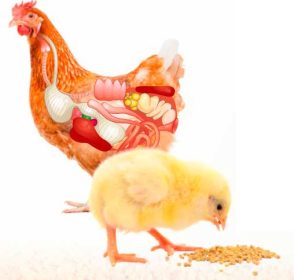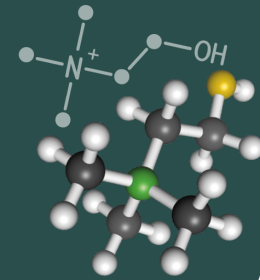
Animal Nutrition
Much more than just a choline replacement
To read more content about aviNews International December 2023
Animal Nutrition
To read more content about aviNews International December 2023
Choline plays an important role in animal nutrition. Choline has four vital functions in the organism (NRC, 1994; Leeson and Summers, 2001):




CHOLINE DEFICIENCIES
When birds do not receive enough choline, the deficiency is manifested by reduced growth and reproductive performance. This is most likely related to lipid accumulation in the liver.
In laying hens, it is shown with a decrease in egg production and egg size, as well as hatchability. In addition, as in broilers, metabolic problems due to choline deficiency are represented by fatty liver syndrome.
Although raw materials per se already provide a certain amount of choline to the diet, the variability among raw materials and within certain raw materials, as well as their bioavailability, leads to routine supplementation of diets to avoid deficiencies.
For its production, natural gas is reacted with methanol and ammonia to produce trimethylamine (TMA); then, in a second reaction with ethylene dioxide to form choline; and finally, the alkaline base is reacted with hydrochloric acid to produce the chloride salt (Griffith and Nye, 1971).
In general, the higher the quality of the product, the lower the residues.
In addition, the use of CC often presents other handling-related disadvantages, which are detailed below:
A) HYGROSCOPICITY AND CORROSIVITY: One of the most important and at the same time most common problems in the use of choline chloride is the hygroscopicity of powder products and the corrosivity of liquid products.
Due to these handling difficulties, many vitamin premix manufacturers no longer include CC in their formulations to avoid vitamin degradation, but also to avoid lumping and compaction of the product due to the hygroscopicity of the product.
B)DEGRADATION OF VITAMINS AND PIGMENTS: Vitamins have highly variable stability values depending on storage conditions and may vary further depending on environmental conditions, especially temperature, humidity and exposure to light, and other premix ingredients, among other factors.
Some authors have studied the effect of choline chloride on vitamin stability. Whitehead (2002) obtained a loss of vitamins between 2 and 38% per month in a premix with CC during 6 months.
C) EXCESSIVE CHLORIDE INTAKE: The chloride contribution of choline chloride should be considered when formulating diets because some metabolic disorders are related to excess chloride in the diets, such as metabolic acidosis, tibial dyschondroplasia and ascitic syndrome.
The negative contribution of CC on total Cl- and electrolyte balance is magnified by other chloride-rich ingredients, such as Lysine-HCl and common salt, leading nutritionists to replace part of the common salt with sodium bicarbonate to meet sodium levels or to add potassium carbonate to counteract excess chloride, in both cases, increasing dietary costs.
D) DOSAGE: Choline chloride can be found in the markets in different concentrations, the most common being 50 and 60% in powder and 75% in liquid.
Important: these are the percentages of choline chloride concentration in the product, not the pure choline content.
Taking into account the molecular weights, approximately 25% of the CC is not pure choline but chloride content. Thus, we must deduct 25% of the concentration to calculate the satisfaction of nutritional requirements.
E) GENERATION OF TRIMETHYLAMINE: In addition to the TMA content commonly present in the product, it is important to note that TMA is also formed along the gastrointestinal tract through fermentation of choline chloride by the microbiota, amplifying the amount of TMA to which supplemented animals are exposed.
Studies show that up to 2/3 of the amount of CC supplied in a diet can be lost as TMA prior to absorption, reducing the efficacy of supplementation and generating potential toxicity to domestic animals.

Why use an ALTERNATIVE to SYNTHETIC CHOLINE CHLORIDE?
Currently, there are natural forms of choline based on polyherbal products, such as NATU-B4 ™, which can replace 100% of choline chloride with many advantages with respect to its use in animal feed.

HOW TO CHOOSE AN ALTERNATIVE TO SYNTHETIC CHOLINE CHLORIDE
For direct replacement
We see that polyherbal products are a good alternative to synthetic choline chloride, but not all polyherbals are the same, we must consider the quality of these products, and for this we will look at:
To be much more than a choline replacement
With Natu-B4™ we have the opportunity to not only be a 100% natural choline chloride replacement, but thanks to nutrigenomics and transcriptomics studies, Natu-B4™ is one of the first polyherbal products to have its mode of action scientifically proven demonstrating that:
CONCLUSIONS
Therefore, we have seen how among the alternatives to Choline Chloride, polyherbal products, mainly Natu-B4™, besides supplying all the functions that Choline Chloride does, and demonstrate that possess other functions such as energy repartition and performance improvements, together with a much easier handling and more environmentally friendly than Choline Chloride (derived from petroleum).
In addition, it has a lower and more stable inclusion cost, as it is not directly dependent on fluctuations in the price of oil and its derivatives.